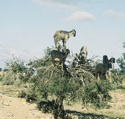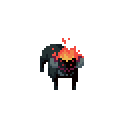|
Tree Goat posted:good post that post reminds of of this youtube channel which recreates 18th century recipes: https://www.youtube.com/watch?v=T2AG545WIsg They have a lot of good videos, though I picked this one because it used to be titled "Orange Fool," and made a bunch of people insanely mad who thought it was a secret jibe at Donald Trump. Most of the recipes they recreate come from books that appear to be written for relatively well off but not necessarily rich persons. It's pretty clear that even families out on the frontier would have had some access to imported spices, sugar, and coffee, with nutmeg in particular appearing over and over again in many recipes. Reviewing the content of the books its fairly likely even working class families would have been using these ingredients and products at least occasionally. The biggest limitation in their cooking seems to be controlling temperature, which must have been a real pain in the rear end before modern precision stoves and ovens.
|
|
|
|

|
| # ? May 28, 2024 02:06 |
|
Squalid posted:that post reminds of of this youtube channel which recreates 18th century recipes: I discovered this channel a couple weeks ago. It is indeed good stuff. Squalid posted:The biggest limitation in their cooking seems to be controlling temperature, which must have been a real pain in the rear end before modern precision stoves and ovens. Ovens were big lumps of masonry with a hole in it. You have a blazing fire in the cavity to warm the masonry up, then shovel out all the embers and slide in whatever you wanted to bake. Obviously the precision here was not excellent.
|
|
|
|
System Metternich posted:The Viennese bought their food either at bakeries, street market stalls, specialised or general storefronts or at the many various farmer's markets, most of which were held weekly or even twice a week. Doesn’t sound too uncommon from nowadays either, even if Naschmarkt is more of a tourist trap than anything else.
|
|
|
|
Kurtofan posted:france has disputes with suriname over guiana jungle borders i think Yeah, also "disputes" is a weird way of phrasing it. Really there should be differentiation in the colors for "disputes where anyone gives a poo poo" and "totally inconsequential like whether a border runs through a mountain summit or 1 inch to the south of the mountain's summit". It seems like a lot of the disputes are for river or lake borders where it's not clear whether the thalweg is the marker or the center is the marker like in Lake Malawi, Lake Constance, the Chobe river, or the Shatt el Arab. It'd be interesting to see that map re-colored with "land disputes" versus "water disputes". Although I guess relatively inconsequential things like that can be more relevant as a casus belli than a 'real' border dispute like the Golan Heights (e.g. Shatt el Arab). Also while thinking about this, I thought Australia had a border dispute with East Timor, but apparently that was solved two months ago ( http://www.news.com.au/finance/econ...7abddd709dfd510 )
|
|
|
|
System Metternich posted:Warning: below follows a loooong post that concerns itself with the diet of early modern inhabitants of Vienna, which is something I know about and which seems to come up in discussion every now and again. Vienna was recognised as being extraordinary in this regard already by the people living back then, but I think that it nevertheless could serve to show that "early modern god botherers" probably were rarer than one might think. Vienna was a foodie paradise when I visited it a few years ago and I'm delighted to know it was that way for centuries
|
|
|
|
Squalid posted:They have a lot of good videos, though I picked this one because it used to be titled "Orange Fool," and made a bunch of people insanely mad who thought it was a secret jibe at Donald Trump. lmfao
|
|
|
|
Milo and POTUS posted:lmfao my like only brush with relevance is that i was quoted in an article about the situation
|
|
|
|
System Metternich posted:Food chat I'm going to save this for the next food derail. Thanks. Great info!
|
|
|
|
Kurtofan posted:france has disputes with suriname over guiana jungle borders i think And I thought Libya had a beef with Chad over the Aouzou Strip (yes I had to look up the name). WP says some international court ruled in favor of Chad in 1994, so did Libya just give up after that point, or is the map in error (as it is several places we've noted) and Chad should be red too? Fun fact about Libya and Chad, their 1987 conflict is known at the Toyota War. Apparently Chad didn't have any decent armor to counter the hundreds of tanks Libya sent across the border (presumably pretty obsolete old Soviet jobs), but they appealed to their French allies, who provided them with a bunch of Toyota Hiluxes and Land-Cruisers, and a bunch of MILAN anti-tank missiles. The Chadians would find hollows in the terrain to lay low until a Libyan tank formation was passing by, then tear rear end across the desert too fast for the tank turrets to track them, and fire MILANs from multiple trucks until they clobbered the Libyan tanks. https://en.wikipedia.org/wiki/Toyota_War
|
|
|
|
Glad you guys liked it!   The creator of the map posted:Here are the multilingual anthems that are not mentioned in the map: Switzerland: “When in morning-red you come from there, I see you in an ocean of light” (German), “On our mountains, when the the sun announces a shiny awakening” (French), “When bright dawn gilds the morning” (Italian), “In the dawn of tomorrow the human being greets you” (Romansh). Andorra
|
|
|
|
A Buttery Pastry posted:This goes for all of Europe except south-eastern Ukraine and the parts that are still hella forested. I think the difference is that the UK is an island. We built loads of huge ships. Then later in WW2 every single bit of spare land that could be had to be farmed because of the u boat blockades etc. It was like a medieval siege of a castle on a national level. They are trying to re forest areas but it's not the same really. I love huge ancient forests there is some thing about them that is magical.
|
|
|
|
loving lol at Belorussia.
|
|
|
|
Jippa posted:I think the difference is that the UK is an island. We built loads of huge ships. Then later in WW2 every single bit of spare land that could be had to be farmed because of the u boat blockades etc. It was like a medieval siege of a castle on a national level. You can sorta see the same thing in the US with the Great Plains and the Midwest being essentially bereft of trees compared to the South or New England. The reasoning is probably similar at least in the Midwest's case.
|
|
|
|
System Metternich posted:Glad you guys liked it! It’s always amusing when England play Liechtenstein as the English fans get confused over which anthem to boo.
|
|
|
|
Orange Devil posted:loving lol at Belorussia.  Also, I loving hate our current anthem. "God help, please, help God, help. . ." Compare and contrast with the defiance of: (mediocre translation stolen from wiki) "There lives, there lives the Slavic spirit, It will live for ages! In vain threatens the abyss of Hell In vain the fire of thunder! Let now everything above us be blown away by the Bura. The stone cracks, the oak breaks, Let the earth quake! We stand firm like the big cliffs"
|
|
|
|
Jippa posted:I think the difference is that the UK is an island. We built loads of huge ships. Then later in WW2 every single bit of spare land that could be had to be farmed because of the u boat blockades etc. It was like a medieval siege of a castle on a national level. Not sure the UK being an island makes it particularly exceptional though. Forest cover in Denmark in the year 1800 was 3-4%, while it was 6-7% in the UK. That was our lowest point though, while you continued until around WW2, pushing you down to 5%.
|
|
|
|
System Metternich posted:Glad you guys liked it! Greece is hardcore
|
|
|
|
Isn't Charlemagne literally "Charles the Great"* so the lyric "The great Charlemagne" is basically "The great Charles the Great". *AKA Big Chuck
|
|
|
|
 You can see farcry 5
|
|
|
|
If you replaced everything on that map with doner kebab the map would still be correct.
|
|
|
|
Saladman posted:Yeah, also "disputes" is a weird way of phrasing it. Really there should be differentiation in the colors for "disputes where anyone gives a poo poo" and "totally inconsequential like whether a border runs through a mountain summit or 1 inch to the south of the mountain's summit". I wonder how many disputes like that are because of some event that altered a rivers course or drained a lake, it can't be zero right?
|
|
|
|
West Virginia has fewer neoconfederate groups than I expected. I mean, they hated the OG Confederacy so much they broke from Virginia over it, but you’d never suspect that from visiting the place.
|
|
|
|
mandatory lesbian posted:I wonder how many disputes like that are because of some event that altered a rivers course or drained a lake, it can't be zero right? River course changes cause frequent issues. The U.S. and Mexico swapped land around the Rio Grande. Netherlands and Belgium recently swapped land adjacent to the River Meuse, precipitated by jurisdictional problems relating to a headless corpse. Platystemon fucked around with this message at 13:58 on May 11, 2018 |
|
|
|
Xelkelvos posted:You can sorta see the same thing in the US with the Great Plains and the Midwest being essentially bereft of trees compared to the South or New England. The reasoning is probably similar at least in the Midwest's case. the trans-mississippi midwest was always more of an open prairie than forested. ohio and indiana though should be more forested than they are, if it weren't for crop-based deforestation
|
|
|
|
System Metternich posted:words about food thanks for this awesome post This guy is making old Dutch recipes from the 1700's on his youtube channel: https://www.youtube.com/watch?v=jdyhRGwHN4Y ekuNNN fucked around with this message at 14:01 on Jul 11, 2018 |
|
|
|
Re: European forestation, it's a quite interesting topic actually. Deforestation and reforestation form sort of a wave curve, closely correlated with population development. As early as the 5th century BC, Plato notes that in earlier times the area around AthensCritias, 111 posted:was unimpaired, and for its mountains it had high arable hills, and in place of the “moorlands", as they are now called, it contained plains full of rich soil; and it had much forestland in its mountains, of which there are visible signs even to this day; for there are some mountains which now have nothing but food for bees, but they had trees no very long time ago, and the rafters from those felled there to roof the largest buildings are still sound. And besides, there were many lofty trees of cultivated species; and it produced boundless pasturage for flocks. Moreover, it was enriched by the yearly rains from Zeus, which were not lost to it, as now, by flowing from the bare land into the sea; but the soil; it had was deep, and therein it received the water, storing it up in the retentive loamy soil and by drawing off into the hollows from the heights the water that was there absorbed, it provided all the various districts with abundant supplies of springwaters and streams, whereof the shrines which still remain even now, at the spots where the fountains formerly existed, are signs which testify that our present description of the land is true. The Romans were quite bad (or good, depending on the viewpoint) at deforestation, and many mediterranean areas like e.g. Italy's macchie are actually anthropogenic in origin. They had some scholars reflecting on this and the Imperial government even enacted some reforestation and protection measures, but it seemed to have been too little to actually make a difference. Central European forests had a great comeback after the collapse of Roman control in the area, and I'd imagine that in other parts of Europe similar developments occured alongside the general decrease in population numbers. While there were many forest clearance measurements happening during Carolingian times, they were restricted to relatively accessible with good soil; forests near rivers or in mountaineous areas remained mostly untouched for centuries. It was only the rapid population increase beginning in the High Middle Ages that saw deforestation and forest clearances on a wide scale, with the remaining old-growth forests in Western and Central Europe being gone by ~1400. Despite a great number of measures enacted by local officials to conserve the remaining forests, worries about a scarcity in timber remained a constant from about that time until the late 19th century, and not even the devastations of the Thirty Years' War put a lasting dent in that development. The whole affair became critical when the population exploded from the late 18th century onwards. Add to that an energy-hungry industrialised economy and it's no wonder that much of Great Britain is deprived of forests even nowadays. A change in thought and practice only came about from around 1850 onwards, helped by the economy shifting from wood to coal and oil as fuel. Another important factor probably was Romanticism as an intellectual and artistic movement that especially in Germany did much to mythologise and romanticise the forest, elevating it from only being seen as something to be used and exploited to an important factor in Germany's national identity that is to be kept and cared for. This is also where the earliest movements concerned with environmental conservation came from. The reforestation and conservation efforts done from then until today are really quite remarkable; Germany for example hasn't had as many forests as it does today for at least the last seven centuries. Here is a neat map that shows the return of forests in 20th century Europe: 
|
|
|
|
That gif is seriously triggering me by having a mid-range green not in the legend.
|
|
|
|
SaltyJesus posted:Compare and contrast with the defiance of: The Flemish anthem is also ridiculously violent and bombastic for such a meek people. https://en.wikipedia.org/wiki/De_Vlaamse_Leeuw quote:The sign of revenge has been given, he is tired of their bait; [chanted by middle-aged suburban accountant] The Walloon anthem is more grounded, but it also has a bitter taste after the developments of the last half-century. https://en.wikipedia.org/wiki/Le_Chant_des_Wallons quote:Of our land Wallonia we are proud.
|
|
|
|
Looking at that gif, you wouldn't imagine the Netherlands were more densely populated than Belgium. A good demonstration of the benefits of close management of land use and zoning, a thing that has failed in Belgium.
|
|
|
|
Got to love Poland and Ukraine. "We're not dead, at least not yet, check back soon"
|
|
|
|
Why is Norway missing data on so many maps?
|
|
|
|
Randandal posted:Why is Norway missing data on so many maps? A lot of times it's because the data comes from the EU, and Norway isn't a member of the EU.
|
|
|
|
Randandal posted:Why is Norway missing data on so many maps? A lot of these maps take data from the EU27+CH surveys which, as the name implies, include only EU member states and Switzerland.
|
|
|
|
Randandal posted:Why is Norway missing data on so many maps? If you're referring to the gif I posted I guess it's because Norway isn't part of the EU. Switzerland isn't one either though, and they were included there - maybe the EU + Switzerland funded the project behind this which then didn't bother to include anyone else? Though that's just a guess, I don't know in this case. e: Beaten badly, though I looked it up: "my" gif was part of the GHG-Europe project, in which a ton of universities and other institutes all over the EU participated as well as the ETH Zürich in Switzerland. I couldn't find any sign that the project was founded by anyone else besides the EU, but I wouldn't exclude it either System Metternich fucked around with this message at 19:53 on May 11, 2018 |
|
|
|
It makes me happy that the map accurately represents the Zuiderzee/IJsselmeer conversion
|
|
|
|
Golbez posted:It makes me happy that the map accurately represents the Zuiderzee/IJsselmeer conversion Just look at that land being created.
|
|
|
|
System Metternich posted:I couldn't find any sign that the project was founded by anyone else besides the EU, but I wouldn't exclude it either Usually this is even more complicated, as due to some political machinations EU can not fund Swiss research, at least via thei main science programme H2020. Instead Swiss apply EU money as an EU institution, but are actually paid by Swiss goverment with equal funds. Complicated system to keep up appearances.
|
|
|
|
System Metternich posted:Glad you guys liked it! The Romanian anthem is pretty
|
|
|
|

|
|
|
|

|
| # ? May 28, 2024 02:06 |
|
My dream is to live in a world where people use the term "European subcontinent".
|
|
|











 In addition to fish, people also ate increased amounts of crabs, oysters, mussels, snails and frogs and of course stuff like beaver and otter which also counted as fish.
In addition to fish, people also ate increased amounts of crabs, oysters, mussels, snails and frogs and of course stuff like beaver and otter which also counted as fish.































